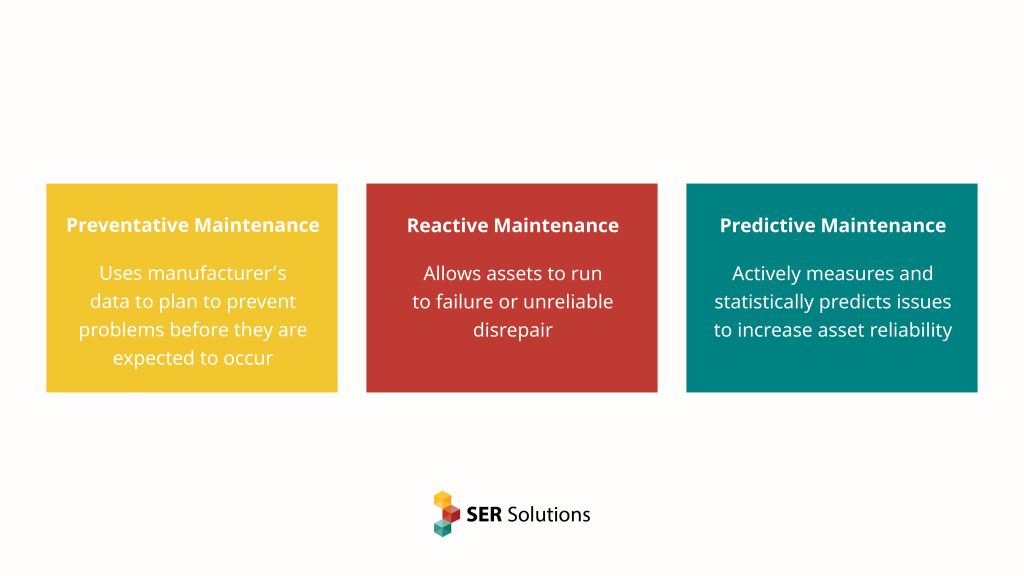Planned maintenance is a preventative measure used to maximise capital investment. After all, you want your assets to go the distance, don’t you?
If your organisation, company or business has a reactive maintenance strategy, the consequences that relate to a lack of forward thinking and planning can include:
- Reduced safety
- High levels of unplanned downtime
- Operations and Maintenance labour inefficiency
- Shortened asset life
- Increased labour costs
- Customer contract risk

Ultimately, by not having a planned maintenance schedule, you won’t have a hope in hell of maximising your return on investment. You’re quite literally banking on your assets having a certain “shelf life” through a run-to-fail plan. While all forms of equipment will eventually wear out, there are many factors that are within your control in terms of optimisation.
What Does Planned Maintenance Look Like For Businesses
This usually depends on the size of your operation and the industry that you trade in. When it comes to planning and scheduling of your asset maintenance, typically there are three approaches:
- Predictive Maintenance – actively measures and statistically predicts issues to increase asset reliability
- Preventative Maintenance – uses manufacturer’s data to plan to prevent problems before they are expected to occur
- Reactive Maintenance – allows assets to run to failure or unreliable disrepair
Cost-wise, a reactive maintenance strategy sounds great in theory – until something goes wrong. A survey conducted in the United States indicated that unplanned downtime was costing the automotive industry an average of $22,000 per minute – or an eye watering $53 million per week. Suddenly, investing the time and resources into a planned maintenance schedule doesn’t seem so drastic, does it?
Depending on your sector, routine inspections and preventative maintenance tasks may look wildly different. Some may require the services of heavy diesel fitters, abrasive blasters and painters, electricians, or even regularly pest inspections. Planned maintenance can also look like:
- Scheduled vehicle servicing
- HVAC (heating, ventilation, and air conditioning) maintenance
- Fire systems testing
- Electrical circuit testing
- Technology, printing and computer servicing
How To Implement Planned Maintenance
Think of it like a roster – if you know that there’s an annual leave request coming up, you work around it and plan accordingly. Maintaining your assets isn’t much different.
Keep track on what is due when, what is going to need replacing, and who is to conduct the task. Forward thinking will allow you to know what to expect and enable businesses to staff appropriately and to keep a stockpile of parts if required.
Thankfully, keeping on top of planned maintenance in the digital age has never been easier. If you’re ready to ditch the spreadsheet, the good news is that there are a number of good, flexible maintenance management software options available in 2020.
The Bottom Line
If you buy a car, you’ll often get a logbook and (ideally) service it regularly – and maintaining your fixed assets is no different. It’s important to remember that capital investment assets are laying the foundation for future profits, so making a conscious effort to make these last is crucial. If you’re ready to take a good hard look at optimising your capital investments, then it might be time to speak to a professional.
Peter Crane has spent thirty years working with Tier One operating companies, assisting them deliver efficient capital investments, reducing waste, improving their performance and increasing investor confidence. Armed with practical experience in engineering services, capital planning, project delivery, construction management and strategic asset management within the infrastructure and resources sector, Peter offers a unique insight into operational roadblocks – and how to fix them.
If you are interested in educating yourself on how the capital investment lifecycle model works, then why not schedule a discovery call with Peter and the team at SER Solutions today?

